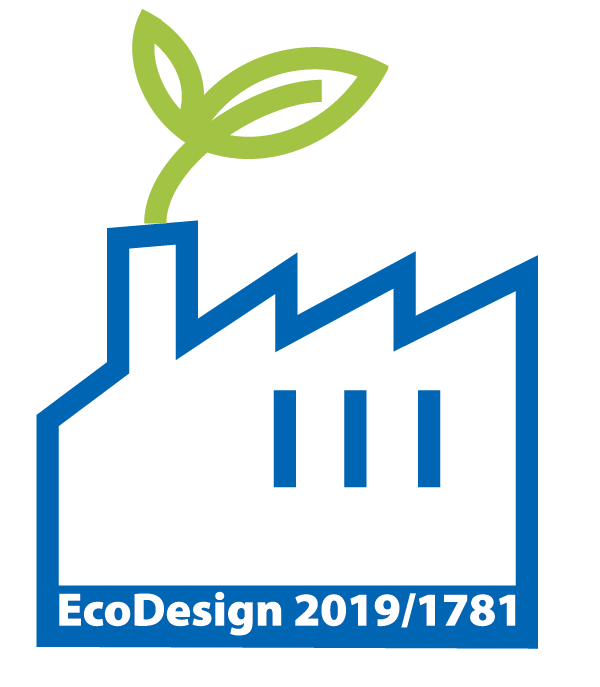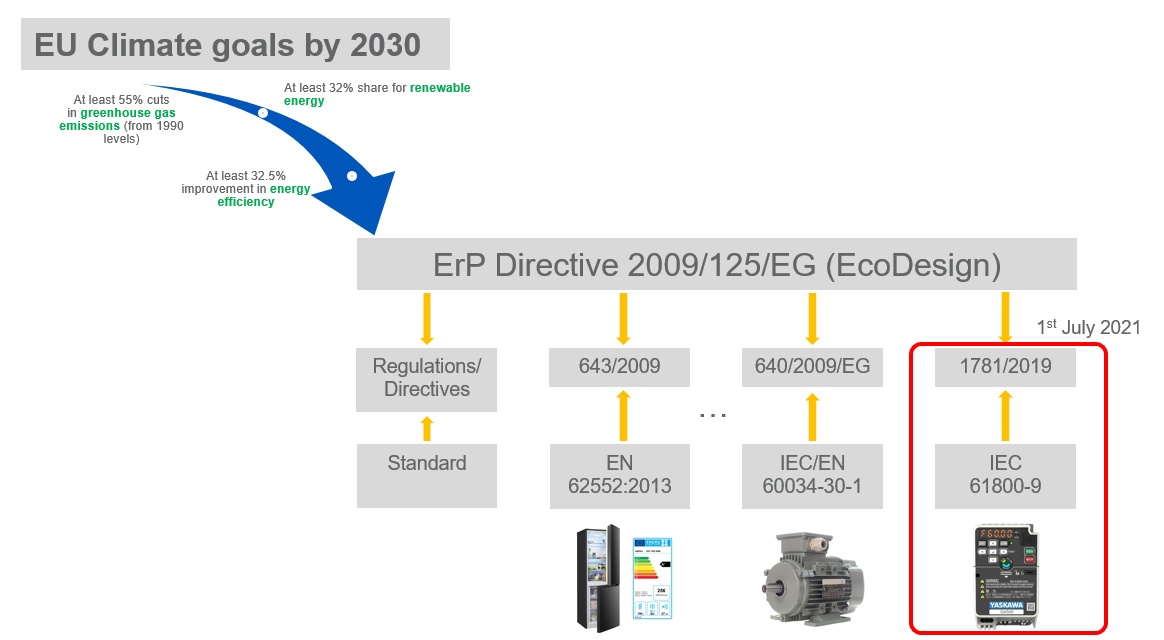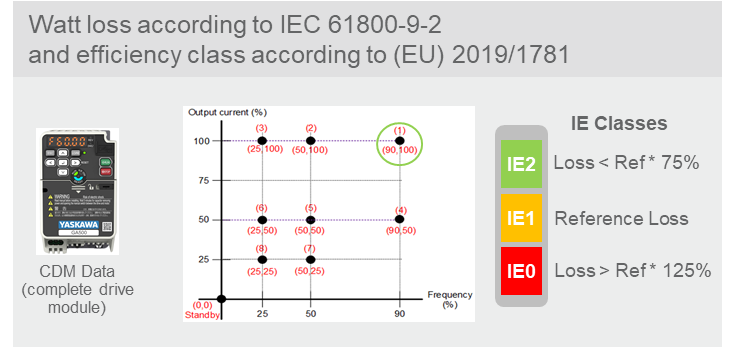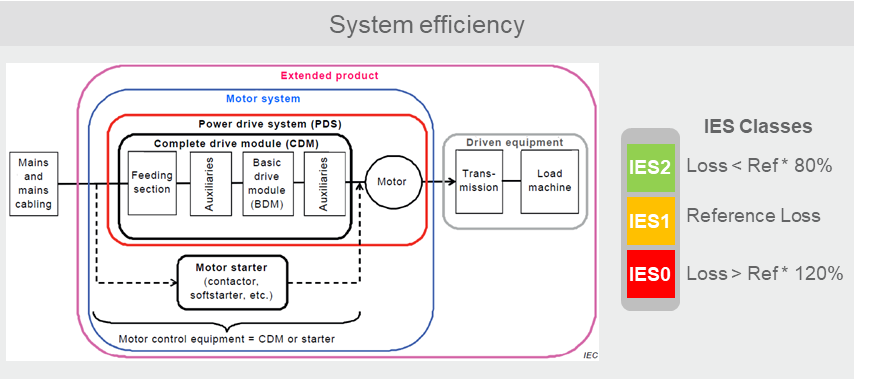More than 100 years committed to technical progress has made us the leading manufacturer in the fields of variable AC drives, servo drives, control technology and robotics.
Energy Efficiency Database
Select your Yaskawa drive in order to retrieve efficiency data according to the EU Ecodesign regulation.
All data shown are for the CDM (complete drive module) as defined in EU regulation 2019/1781. Losses had been determined in accordance with IEC 61800-9.
Regenerative drive such as U1000, U1000L, Z1000U, D1000, R1000, are exempted from the directive and are therefore not covered by the information provided here.

What is the EU Ecodesign regulation about?
At the heart of the matter are the EU’s climate targets, which were tightened once again in September 2020 under the term “Green Deal” and are to be implemented by 2030 in the first phase. Currently the targets are:
- 55% reduction in greenhouse gases compared to 1990
- A share of at least 32% renewable energies in the energy mix
- At least 32.5% better energy efficiency
The aim is to achieve climate neutrality for the EU by 2050.
To achieve these targets, the ErP (Energy-related Products) Directive was created, which is often referred to as the Ecodesign Directive. It provides a framework but does not contain product-specific requirements, as these are so diverse that they cannot possibly be covered by just one directive. Consequently, implementation regulations have been defined, based on the ErP Directive, which regulate the requirements for the energy efficiency of products.
For example, there are now regulations for all kinds of household appliances, which give us the efficiency class labels we are familiar with on televisions, washing machines, refrigerators, lamps and so on. Similar regulations and labels exist for industrial applications such as compressors, fans, pumps, etc., and electric motors, which are estimated to consume half of the electrical energy produced in the EU, have not been spared. However, it was recognized that much more energy could be saved by controlling the speed of electric motors and so Regulation (EU) 2019/1781 was published, which now regulates the efficiency of the variable speed drive that work alongside the motors.

The scope of the regulation is initially limited to asynchronous machines and variable speed drives suitable for controlling these motors. This means that all other types of motors (e.g. synchronous reluctance, permanent magnet) and frequency inverters intended exclusively for controlling such motors do not fall within the scope.
Furthermore, the scope of the regulation is limited to equipment with a 3-phase input and a power of 0.12 to 1000 kW.
Regenerative or single-phase equipment or equipment with harmonic attenuation and the like are currently explicitly excluded.
In terms of Yaskawa’s product portfolio, this means that servo drives such as the Sigma series and the associated motors, as well as regenerative controllers such as the U1000, D1000 or R1000, need not be considered. It only concerns frequency inverters such as J, V and A1000 and their derivatives or GA500 and GA700. For these, specific efficiency values are now binding and must also be specified.
To determine the efficiency of an inverter, the loss values are measured at eight defined load points and in standby according to the IEC 61800-9-2 standard. The loss value at the load point (90, 100) (90% speed, 100% load) is compared with a defined reference value. If it is below 75 % of the reference value, the device corresponds to the highest efficiency class IE2. Frequency inverters that only comply with classes IE0 or IE1 may generally no longer be marketed.

Few machines are actually operated at full load all the time, so efficiency at part load can be much more important in evaluating a system and the (90, 100) point is really secondary. Furthermore, if you want to evaluate and compare the efficiency of machine parts and entire machines, you have to consider all components. The “extended product approach” is aimed specifically at simplifying this.
As a result, the above-mentioned loss values must not only be published for frequency converters, but also for motors at the same operating points. The mechanical engineer can calculate the losses at any operating point using the appropriate formulas from the standard. By adding up the losses of the inverter (CDM) and the motor, you get the losses of the drive system (PDS). If you continue this with the loss values for other electrical and also mechanical components, you end up with the system’s total losses at the various load points and can evaluate its efficiency and also compare it with others.
The system efficiency (motor system or extended product) can be calculated and classified (IES0 to IES2) in the same way as the component using the system’s (90, 100) point.

From a technical point of view, nothing changes at all. Yaskawa frequency converters have always been efficient and continue to be so to the same extent. They exceed the requirements of efficiency class IE2 without any further action.
Nevertheless, there are some modifications with regard to product labelling and documentation.
First, the efficiency class and the relative loss value for the load point (90, 100) are included in the information on our inverters’ nameplate.
New declarations of conformity (DoC) are available, as compliance with the Ecodesign Directive is now also a prerequisite for being allowed to affix the CE mark. The new DoCs are included with most products, but are of course also available in the download area on www.yaskawa.eu.com.
Finally, the loss values at all measuring points must be published together with other specified technical data, which is accomplished by this website.




















